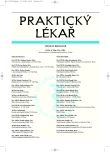Contribution to health aspects of exposure to exhaust emissions
Authors:
M. Tuček 1; V. Bencko 1; J. Volný 2; L. Novotný 1; J. Petanová 3
Authors‘ workplace:
Univerzita Karlova v Praze, 1. LF a VFN
Ústav hygieny a epidemiologie
Přednosta: prof. MUDr. Vladimír Bencko, DrSc.
1; Zařízení zdravotní péče, Generální ředitelství cel, Praha
2; Univerzita Karlova v Praze, 1. LF a VFN
Ústav imunologie a mikrobiologie
Přednosta: prof. MUDr. Ivan Šterzl, CSc.
3
Published in:
Prakt. Lék. 2008; 88(5): 300-304
Category:
Of different specialties
Overview
The authors present the results of a three year follow-up study on a total of 44 customs officers occupationally exposed to exhaust emissions (polycyclic aromatic hydrocarbons, PAHs). Emissions concentrations measured in the customs outdoor workplace vary, with the number cars, from 20 to 980 μg.m⁻³ NOx (on average 180 to 390 μg.m⁻³), and from 1 to 27 mg.m-3 CO (on average 4 to 8 mg.m⁻³). The measurement of the presence of 16 PAHs in the air of the workplace using active personal dosimetry was performed by personal long-term sampling in 25 exposed individuals. Total PAHs levels in the air of the workplace reached, in individual sampling terms, values in the range of 0.11 to 8.96 μg.m⁻³. Biological monitoring established the mean values of the content of 1-hydroxypyrene (1-OHP) in the urine of exposed persons to be 0.56 ± 1.04 μg.g⁻¹ creatinine (maximum 6.30 μg.g⁻¹ creatinine) and in the urine of control individuals 0.08 ± 0.08 μg.g⁻¹ creatinine (maximum 0.30 μg.g⁻¹ creatinine). The observation of parameters of the state of general health included a guided interview with a questionnaire, haematological examination (14 items), biochemical examination of serum (12 items), examination of humoral and cellular immunity (23 items), examination of tumour markers in blood (CEA, NSE, TK, CA 19-9, CYFRA), and cytogenetic analysis of peripheral lymphocytes (CALPL). The health complaints of the examined persons correspond to a normal distribution in a general population of the same age range, 47 % of the exposed customs officers have subjective complaints. Signs of damage to the immune system, compared to the general population, have not been observed except in a few exceptions; an increased level of αα-1-antitrypsin in individuals exposed to the polluted atmosphere was shown in 18 % of the examined subjects, but only once. The life-long risk of carcinogenic effects for the exposed persons turned out to be in the range of 7.2 x 10⁻⁶ to 7.5 x 10⁻⁵ depending upon climatic conditions.
Key words:
custom officers, occupational exposure, exhaust gases, polycyclic aromatic hydrocarbons, health aspects.
Sources
1. Adamec, V., Bencko, V., Dufek, J., Jedlička, J. Persistent organic pollutants in transport emissions and health. The Czech Republic experience. Epidemiology, 16, 2005, 5, p. 146.
2. Bencko,V., Tuček, M., Volný, J. Health aspects of human exposure to exhaust gases. Vol.V, XIV. Asian Conference on Occupational Health, Beijing, China, 1994, p. 423.
3. Bencko,V., Šuta, M., Tuček, M., Volný, J. Health aspects of human exposure to oxidants and exhaust pipe gases. In: Indoor Air 1996, Nagoya, Japan, 1996, p. 1137-1142.
4. Bofetta, P., Jourenkova, N., Gustavsson, P. Cancer risk from occupational and environmental exposure to polycyclic aromatic hydrocarbons. Cancer Causes Control (England), 1997, 8, p. 444-472.
5. Boogard, P. J., van Sittert, N.J. Exposure to polycyclic aromatic hydrocarbons in petrochemical industries by measurement of urinary 1-hydroxypyrene. Occup. Environ. Med. 1994, 51, 4, p. 250-258.
6. Buchet, J. P., Gennart, J. P., Mercado Calderon, F. et al. Evaluation of exposure to polycyclic aromatic hydrocarbons in a coke production and a graphite electrode manufacturing plant: Assessment of urinary excretion of 1-hydroxypyrene as a biological indicator of exposure. Brit. J. Ind. Med. 1992, 49, 11, p. 761-768.
7. Holoubek, I. Osud PAU v prostředí. Polycyklické aromatické uhlovodíky. Sborník ze semináře Aktuální ekologické otázky, BIJO, 1995, s. 23.
8. Jongeneelen, F.J. Biological exposure limit for occupational exposure to coal tar pitch volatiles at cookeovens. Int. Arch. Occup. Environ. Health, 1992, 63, 8, p. 511-516.
9. Jongeneelen, F.J. Benchmark guideline for urinary 1-hydroxypyrene as biomarker of occupational exposure to polycyclic aromatic hydrocarbons. Ann. Occup. Hyg., 2001, 45, 1, 3-13.
10. Kaušitz, J. Rádioimunoanalýza v onkológii. Plzeň: LF UK v Plzni, 1991.
11. King, J.C. Specific nutrient requirements: Trace elements. In: Gershwin, German, Keen (eds.): Nutrition and immunology: principles and practice. Totowa: Humana Press 2000, p. 65-74.
12. Singh, R., Tuček, M., Maxa, K. et al. A rapid and simple method for the analysis of 1-hydroxypyrene glucuronide: a potential biomarker for polycyclic aromatic hydrocarbon exposure. Carcino-genesis 1995, 16, 12, p. 2909-2915.
13. Tenglerová, J., Tuček, M., Maxa, K. a kol. Zhodnocení karcinogenního rizika při profesionální expozici polycyklickým aromatickým uhlovodíkům (PAU). Závěrečná zpráva o řešení grantového projektu IGA MZ ČR 3524 - 3: Doba řešení 1996-1998.
14. Tuček, M., Krýsl, S., Maxa, K., Tenglerová, J. Carcinogenic risk assessment in occupational exposure to polycyclic aromatic hydrocarbons (PAHs).Book of Abstracts. The Fifth International Symposium on Biological Monitoring in Occupational and Environmental Health, Banff , Canada, 2001, p. 17.
15. Tuček, M., Bencko, V., Volný, J., Petanová, J. Příspěvek k odhadu zdravotních rizik expozice výfukovým plynům u celníků na hraničních přechodech. České prac. lék., 2006, 7, 2, s. 76-83.
Labels
General practitioner for children and adolescents General practitioner for adultsArticle was published in
General Practitioner

2008 Issue 5
- Memantine Eases Daily Life for Patients and Caregivers
- Metamizole vs. Tramadol in Postoperative Analgesia
- Metamizole at a Glance and in Practice – Effective Non-Opioid Analgesic for All Ages
- Memantine in Dementia Therapy – Current Findings and Possible Future Applications
- What Effect Can Be Expected from Limosilactobacillus reuteri in Mucositis and Peri-Implantitis?
Most read in this issue
- The late effects of xenobiotics. 1. effect mechanisms and their occurrence in the environment
- History, present problems and challenges in prevention of nosocomial infections
- Violence as a disquieting phenomenon in contemporary health services
- Treatment of tobacco dependence: prevention, diagnosis and treatment in General Practice
